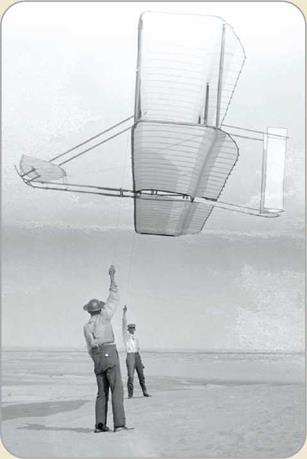Learning About Flying
In 1896, the brothers heard of the death of aviation pioneer Otto Lilienthal, who had a fatal accident while gliding. The story renewed the Wright’s interest in flying, and they began learning all they could about the subject. After the Wrights read everything they could find, they realized that many aviation books contradicted each other. They decided to conduct their own experiments.
The Wrights chose to carry out their tests near Kitty Hawk, a small village on the sandy barrier islands off the North Carolina coast. The area was low, with only one small hill, and had no trees.
Glider Experiments
The Wrights arrived at Kitty Hawk in September 1900 and spent several weeks carrying out tests with their first glider. At first, they flew the glider as a kite, with no one on board. Finally, in late October, Wilbur Wright made several flights.
The next year, the Wrights took a larger glider to North Carolina. Wilbur made more than 100 flights that summer. The brothers were puzzled, however, that the behavior of the wings did not match some calculations published by Lilienthal. They returned to Dayton to begin new experiments. The Wright brothers built a wind tunnel, which they used to carry out hundreds of tests of different wing shapes.
Armed with revised theories, the Wrights returned to North Carolina in 1902 with a new glider. This time, the results were spectacular. The Wrights carried out more than 1,000 glider flights. Some carried them more than 600 feet (185 meters), and once their glider stayed in the air for 26 seconds.
|
О Wilbur Wright, with helper Dan Tate, flies a glider as a kite at Kitty Hawk, North Carolina. The Wright brothers carried out many tests with gliders before they attempted powered flight. |











